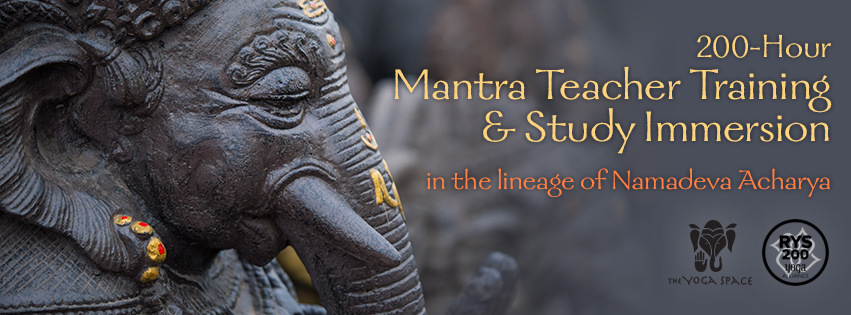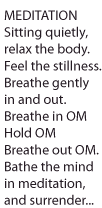 Vision Statement – The vision is to spread the powerful teachings and transformative wisdom of ancient Sanskrit mantra and its healing applications through multiple training programs which educate, empower and facilitate; changing lives, helping to bring health, awareness, freedom and peace to our planet.
Vision Statement – The vision is to spread the powerful teachings and transformative wisdom of ancient Sanskrit mantra and its healing applications through multiple training programs which educate, empower and facilitate; changing lives, helping to bring health, awareness, freedom and peace to our planet.
Welcome!
Imagine a world with an overflow of compassion and love. A world of sacred practices where we honor ourselves, heal and consciously contribute to a world of peace.
The 200-Hour Mantra Teacher Training & Study Immersion, inspired by my teacher, Namadeva Acharya (Thomas Ashley-Farrand), provides you with the opportunity to:
~Deepen your knowledge and experience of Sanskrit mantra,
~Learn the healing and transformative powers of applying Sanskrit mantras to common problems in everyday life,
~Facilitate others and prescribe mantra formulas for their use,
~Teach and apply mantra in yoga classes, body-mind related therapies or other modalities,
~Tap into the power of mantra as a personal study immersion for self-awareness, healing, personal transformation and freedom!
Guided with care by our expert faculty and guest artists, our immersive curricula will prepare you to teach mantra related practices with confidence and depth of knowledge, cultivating your unique style and fullest potential.
Tap into the collective wisdom of the ancient language of Sanskrit, deepen your own practice and share your gifts.
With love and devotion to my teacher Namadeva and my commitment to helping the lineage move forward, I invite you to join me on this sacred path of love and freedom.
In Loving Service,
Rajeshwari
Course Outline and Content:
History of Mantra, Scriptural Background, Lineage of Namadeva Acharya
Through lecture we will cover the history of mantra; myth, oral tradition, earliest writings, the Vedas and Upanishads. We will also discuss the history of Sanskrit and the role of mantra from ancient times to present. We will discuss the lineage of Namadeva Acharya, his style of teaching and main contribution to the mantra path.
Learning Objective: Trainees will know the basic history of mantra, scriptural background, the history of the Sanskrit language and the role of mantra from ancient times to present. Trainees will be able to present basic historical information on mantra and be well versed in the style and attributes of the teachings of Namadeva Acharya.
Overview of Yogic Philosophy; Patanjali’s 8-fold Path, Yoga Sutras, Teacher Ethics
Lecture and discussion on Patanjali’s foundational concepts, key thoughts, and effects of practice, with focus on the 8-fold path as a complete system of yoga; Yamas and Niyamas will be integrated into teacher ethics. We will introduce Patanjali’s Yoga Sutras and study a section from each chapter. Also discussed; Karma, Bhakti, Raja, Jnana, Mantra, Hatha Yoga.
Learning Objective: Trainees will understand the Yoga of Patanjali, the 8 steps to realization as a complete, systematic approach. Trainees will be able to apply ethics to their teaching such as truthfulness, non-violence and service to others. Trainees will reflect on the deeper practices of the Yoga Sutras and are invited to dive deeper into these teachings, if desired.
Introduction to Seed Sounds, Classical Mantras, Sanskrit Hymns
Through lecture, discussion and group chant immersion we will 1) learn the technical aspect of basic seed sounds, classical mantras and Sanskrit hymns, their meaning, correct pronunciation and applications 2) participate in guided practices of mantra japa meditation (repetition of the word) and recitation of hymns.
Learning Objective: Trainees will learn the fundamentals of Sanskrit as an energy-based language with powerful one-syllable seed sounds, classical mantras and Sanskrit hymns. They will know how to use these mantras, what energies they evoke and how to integrate them into personal practices, asana-yoga classes/body mind modalities and everyday life.
Mantra Japa Meditation: Various Disciplines (both verbal & written), Steps for Practice, Mala Use, Altar Practices
Through lecture, discussion and demonstration students will learn 1) various mantra discipline techniques; 21-day informal, 40-day formal, mantra siddhi and likhita japa (repetition through the written word) 2) steps for practice; choosing a mantra, setting, time of day, spiritual diary 3) introduction to the mala (prayer beads); history, use and maintenance 4) altar practices; the importance, creation and maintenance. Trainees will have the opportunity to exercise this knowledge in practice teach sessions.
Learning Objective: Trainees will be able to advise specific mantra disciplines to students with the techniques and guidelines necessary for a successful personal practice.
Mantra Applications; In-depth Study, Meaning & Use
Through lecture and discussion, we will study the energetics of mantra, origin, symbology, meaning and application, and how these ancient divine sounds can be applied to the human condition. We will experience the powerful effects of mantra japa meditation through group chant immersion, guided and silent meditation.
Learning Objective: Trainees will be well versed 1) in the origin, symbology and meanings of a wide variety of Sanskrit mantras 2) in the application and usage of specific mantras, how to incorporate mantra guidance into personal practices, yoga classes, mantra classes, workshops/retreats.
Participation in 21-Day and 40-Day Mantra Disciplines
Students will be required to partake in both a 21-day and a 40-day Mantra Discipline, both as a personal practice and as a group sadhana. Through lecture, discussion and small group inquiry, trainees will create and refine their own personal mantra practice. In addition we will discuss the meaning and significance of structured mantra disciplines. Students will be required to submit written assignments on their daily practices to report personal progress.
Learning Objective: Trainees will be able to teach and facilitate students in 21 and 40 day mantra disciplines as spiritual practices, as well as, understand the significance of this type of structured practice.
Anatomy and Physiology, Physical/Energetic; Chakras, Prana, Nadis, Koshas, Karma
Through lecture, discussion and the use of diagrams, we will 1) study the very basics of human physical anatomy, placement of muscles, bones, organs, glands, etc. 2) study the energetic anatomy and physiology; main chakras, esoteric chakras and their role, 5 types of prana, kundalini energy, the nadis, the 5 koshas or sheaths, as well as, the 4 types of karma. Mantra practices correlating to specific physical and energetic principles will be experienced in class; reading assignments will be given to further study.
Learning Objective: Students will understand the basics of human physical anatomy and will be able to incorporate the many layers of the energetic body into their mantra teachings.
Energetics of Mantra; Sanskrit Alphabet, Pronunciation, Power of Sound; how mantras work directly on our energetic bodies for deep transformation
Through lecture, discussion and group chant we will learn the correlation between our spiritual, energetic anatomy and physiology to the sound vibration of the 50 letters in the Sanskrit alphabet and the 108 beads on a mala. We will learn the correct pronunciation of the Sanskrit alphabet with mouth positions for maximum benefit. We will learn the application of mantras to certain areas of the physical body, as well as, to the chakras, nadis, koshas and karmic life situations.
Learning Objective: Trainees will understand the connection of Sanskrit mantra practice and its benefits to the physical/energetic body. Trainees will be able to teach and apply mantra-based disciplines in accordance to these principles with correct pronunciation.
Yoga, Pranayama, Meditation
Trainees will be guided daily through Hatha Yoga classes, various pranayama techniques and meditation to create balance, increase flexibility, strength and vitality. We will discuss the importance of merging all practices on the 8 limbed path for ultimate purification. Students will also be invited to incorporate yoga, pranayama and meditation into their personal daily practices during the training. Yoga classes will include mantra as a model for application.
Learning Objective: Trainees will obtain benefits from yoga, pranayama, and meditation practices for increased vitality and well-being, as well as, develop conditions ripe for integrating the teachings in the training. Trainees will also be able to effectively teach mantra in yoga classes and other group settings.
Basics of Ayurveda; Doshas, Gunas, Healthy Lifestyle & Daily Self-Care
Through lecture, demonstration, group and personal practice, we will introduce the fundamental principles of Ayurveda; the three doshas, gunas, healthy lifestyle and Dinacharya, the daily routine of self-care. Trainees will be required to choose self-care techniques to practice and provide written assignments that document their experience.
Learning Objective: Trainees will know the fundamental principles of Ayurveda, understand their unique mind and body type (dosha), have tools to live a healthy lifestyle, have the knowledge and experience to apply Dinacharya, the Ayurvedic daily routine of self-care, designed to maintain and reconnect to the circadian rhythms. Trainees will understand the importance of self-care as a teacher to help keep the senses and mind clear and body nourished, understand the use of these practices as a role model to their students, and will be able to incorporate this knowledge to their mantra teachings.
Gods & Goddesses; Principles, Symbology, Application
Through myths, mantras and discussion, we will study a non-dogmatic approach to Gods and Goddesses, Hindu deities, their symbology and energetic importance in the role of transformation and mantra meditation. In addition, we will learn how to apply mantras in this category to specific life conditions and situations.
Learning Objective: Students will be well versed in the symbology, application and energetic importance of Gods and Goddesses.
Transformation through Sacred Art & Vedic Ceremony
Through demonstration and participation with guest artists; 1) Sacred Art; we will create/play/sculpt, as a form of meditation, yantras, mandalas, personalized malas (prayer beads), and murthis (statues/divine spirits) 2) participate in basic Arati Ceremony and traditional Vedic Puja Ceremony (Shodasho-Pachara, 16 form) with lead trainer/pujari/vedic priest, as a way to experience and cultivate additional devotional practices on the Bhakti Yoga path. Sections of this portion of the training will include dynamic group chant.
Learning Objective: Trainees will experience the beauty and power of sacred art designs and be able to lead mantra meditations which incorporate sacred geometry. As we create/sculpt with Guest Artists, trainees will have a personalized mala to practice with and sacred items for their home altar! Trainees will also be introduced to traditional Vedic ceremony to study further, if desired. They will understand the role of mantra in traditional Vedic ceremony as a means for deep transformation.
Guest Kirtan Artists; Devotional Music, Song & Mantra
World-renowned Guest Kirtan Artists/Musicians will visit our training to immerse trainees in the sacred sounds of mantra through music and song. An opportunity to quiet the mind, relax and celebrate the yogic path!
Learning Objective: Trainees will experience the celebration of mantra through devotional music and song. Trainees will be able to apply music and mantra into their teachings, if desired.
Mantra Teachings; Class, Workshop, Retreat Design
Through lecture, discussion and small group forum, we will introduce the skillful design of organizing mantra classes, workshops and retreats. We will cover location, clientele, length of offering, and general contents.
Learning Objective: Trainees will be able to design simple mantra classes, workshops and retreats. Trainees will have opportunities to create class outlines with the support of their peers as preparation for practice teach sessions.
The Art of Teaching; General Principles
Through discussion we will cover how to create the optimal learning environment for mantra teaching, in-class communication skills, working with different populations, group teaching verses privates, style and qualities of teaching for maximum benefit, teaching as a service, boundaries and the student/teacher relationship. The art of meeting each student where they are in development and how to assist them in their learning and growth process will be addressed.
Learning Objective: Students will be able to exercise the teaching methods discussed, utilizing these methods during practice teach sessions, receiving feedback and refining their skills.
Mantra as a Business; Key Elements, Vision & Marketing
Lecture and discussion on all key elements of the business aspect of mantra teaching. Trainees will have the opportunity to create a vision statement, business plan and ideas for effective marketing, if desired. What to charge for services and effective financial strategies will also be discussed.
Learning Objective: Students will be well prepared to teach mantra related practices with a personalized business plan, plus financial and marketing strategies in place upon graduation of the training.
Practice Teach Sessions, Certification, Graduation
Trainees will be required to practice teach in small groups throughout the training, applying all techniques and material covered in the program in a variety of different ways 1) facilitating private one-on-one mantra sessions 2) leading group mantra classes/workshops/ retreats 3) incorporating mantra into yoga classes and/or other bodymind modalities. For maximum benefit, including practices of pranayama and meditation instruction within the teachings of mantra is also required. Study group time and one-on-one consultations with the lead trainer for preparation of practice teaches are included. Receiving and giving feedback via feedback forms included. Graduation from the program includes a sacred ceremony to honor the time, commitment and devotion applied to their studies.
Learning Objective: Trainees will refine their skills to teach effectively and with confidence the material covered in the mantra teacher program. Trainees will be well versed in preparation of material, leading/teaching mantra-based practices with a variety of applications, and have the ability to follow up with students where applicable.
A training manual, supplementary mantra handbook, plus new mantra recordings by Rajeshwari will be included in the training course.
Sanskrit mantra is a vital part of the yogic path; it combines sound, awareness, sense withdrawal, focus, concentration, and meditation. Mantras can be used as a primary practice and can also be combined with the physical practices of yoga. With the increased popularity of yoga today and the abundance of certified yoga teachers around the globe, it is vital to merge these practices with authentic and proper teachings. This one of a kind training is a unique opportunity.
CURRICULUM CONTENT HOURS
(as determined by Yoga Alliance)
Teaching, training and practice: 100
Teaching methodology: 25
Anatomy and physiology: 20
Yoga philosophy, lifestyle and ethics for teachers: 30
Practicum: 10
Other: 15
Total: 200
TRAINING BOOKS AND MATERIALS:
On the first day of the training, students will receive a complimentary 200-Hour Mantra Teacher Training & Study Immersion Manual, a supplementary Mantra Handbook, and recorded materials by Rajeshwari.
Additional Required Reading: (not included in tuition fee)
1) Healing Mantras by Namadeva Acharya
2) Shakti Mantras by Namadeva Acharya
(books above available at The Yoga Space or online at www.sanskritmantra.com)
3) The Yoga Sutras of Patanjali (suggested version by Sri Swami Satchidananda)
(online at http://www.amazon.com/Yoga-Sutras-Patanjali-Swami-Satchidananda/dp/1938477073)
Suggested Books and Recordings:
Books
1) Chakra Mantras by Namadeva Acharya
(available at The Yoga Space or online at www.sanskritmantra.com)
2) Gayatri, The Highest Meditation by Sadguru Sant Keshavadas
3) Ramayana at a Glance by Sadguru Sant Keshavadas
(books above available online at http://www.templeofcosmicreligion.org/Store/Books/books.html)
4) Yoga & Ayurveda: Self-Healing and Self-Realization by David Frawley
5) The Shakti Coloring Book by Ekabhumi Charles Ellik
(available online at http://www.soundstrue.com/store/the-shakti-coloring-book.html)
Recordings (available as CD’s or downloads online at www.sankritmantra.com)
All recordings by Namadeva Acharya are highly recommended!
Specifically: Healing Mantras, Mantras of the Goddess, Gayatri Mantra Meditations
Om Gam Ganapatayei Namaha
(Salutations to Lord Ganesha, the remover of obstacles, through the principle of internal unity)






